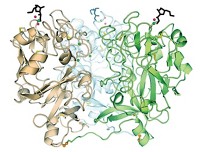Advertisement
Grab your lab coat. Let's get started
Welcome!
Welcome!
Create an account below to get 6 C&EN articles per month, receive newsletters and more - all free.
It seems this is your first time logging in online. Please enter the following information to continue.
As an ACS member you automatically get access to this site. All we need is few more details to create your reading experience.
Not you? Sign in with a different account.
Not you? Sign in with a different account.
ERROR 1
ERROR 1
ERROR 2
ERROR 2
ERROR 2
ERROR 2
ERROR 2
Password and Confirm password must match.
If you have an ACS member number, please enter it here so we can link this account to your membership. (optional)
ERROR 2
ACS values your privacy. By submitting your information, you are gaining access to C&EN and subscribing to our weekly newsletter. We use the information you provide to make your reading experience better, and we will never sell your data to third party members.
Biological Chemistry
Antibody-Loving Protein Binds Around
Newly discovered bacterial protein binds a cornucopia of antibodies, a property that could be leveraged to help purify the antibodies
by Sarah Everts
February 10, 2014
| A version of this story appeared in
Volume 92, Issue 6
A wildly promiscuous protein produced by pathogenic Mycoplasma, such as those that cause genital and respiratory tract infections, appears to have the ability to bind any antibody it encounters—including those from humans, mice, rabbits, pigs, and goats. In doing so, the protein covers up the variable section of the antibodies, preventing them from hooking up with their intended targets (Science 2014, DOI: 10.1126/science.1246135). Researchers led by Richard A. Lerner of Scripps Research Institute California have named the antibody-interfering molecule Protein M. They believe it is unique because its crystal structure does not appear in the Protein Data Bank, the international online structure repository. Protein M is not the only pathogenic protein known to bind a variety of antibodies, but it is the largest discovered to date. Lerner’s team proposes that the protein could find good use in industry as a tool to purify antibodies. Still to be learned is exactly how the bacteria employ the protein for their own gain, although the pathogens presumably produce the protein to interfere with host immune responses and thus allow chronic infection.





Join the conversation
Contact the reporter
Submit a Letter to the Editor for publication
Engage with us on Twitter